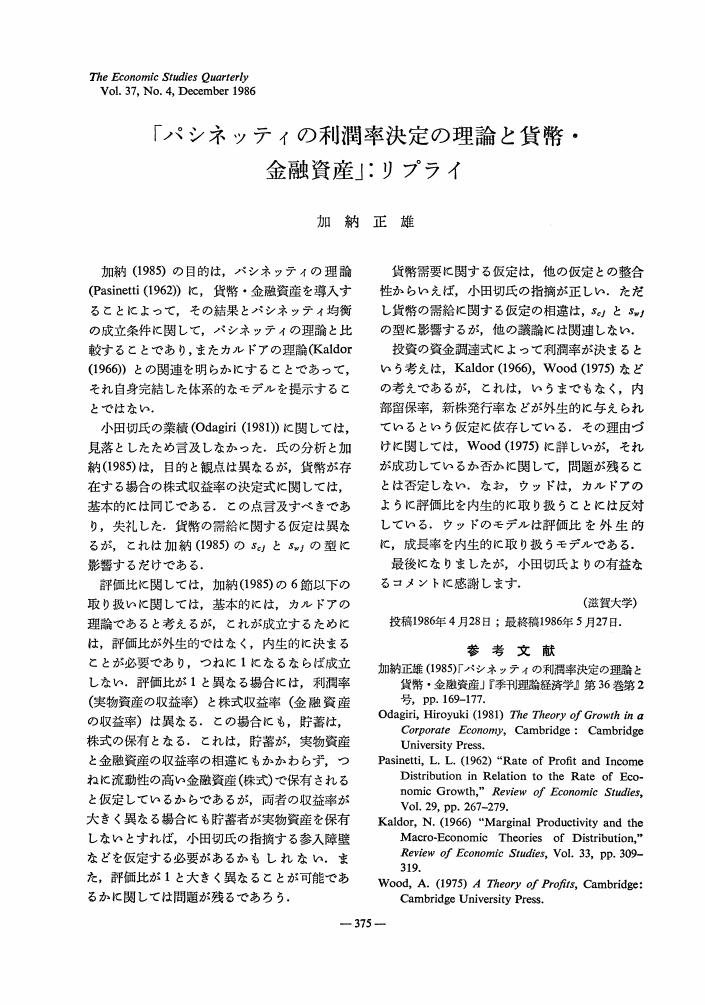2 0 0 0 OA アメリカのNCEEと日本の経済教育の比較研究 : 仕事と職業に関して
- 著者
- 加納 正雄
- 出版者
- 滋賀大学
- 雑誌
- 滋賀大学教育学部紀要. I, 教育科学 (ISSN:13429280)
- 巻号頁・発行日
- vol.58, pp.157-171, 2008
- 被引用文献数
- 2
2 0 0 0 IR 利潤の内部留保と国民所得及び分配の決定 : 短期におけるカルドアの新パシネッティ定理
- 著者
- 加納 正雄
- 出版者
- 滋賀大学
- 雑誌
- 滋賀大学教育学部紀要. 人文科学・社会科学・教育科学 (ISSN:05830044)
- 巻号頁・発行日
- vol.28, pp.45-50, 1978
2 0 0 0 OA アメリカのNCEEと日本の経済教育の比較研究 : 金融教育に関して
- 著者
- 加納 正雄
- 出版者
- 滋賀大学
- 雑誌
- 滋賀大学教育学部紀要. I, 教育科学 (ISSN:13429280)
- 巻号頁・発行日
- vol.57, pp.113-124, 2007
1 0 0 0 OA 「パシネッティの利潤率決定の理論と貨幣•金融資産」: リプライ
- 著者
- 加納 正雄
- 出版者
- 日本経済学会
- 雑誌
- The Economic Studies Quarterly (ISSN:0557109X)
- 巻号頁・発行日
- vol.37, no.4, pp.375, 1986-12-20 (Released:2007-10-19)
- 参考文献数
- 5
1 0 0 0 OA ケインズ『貨幣論』と利子理論
- 著者
- 加納 正雄
- 出版者
- The Japanese Society for the History of Economic Thought
- 雑誌
- 経済学史学会年報 (ISSN:04534786)
- 巻号頁・発行日
- vol.33, no.33, pp.90-100, 1995 (Released:2010-08-05)
- 参考文献数
- 15
Keynes' argument that income can change without any change in the quantity of money appears in his Treatise on Money. This argument is essentially concerned with the theory of interest and the equilibrium condition in the money market, but Keynes' argument in the Treatise concerning these matters has not been sufficiently analyzed. The purpose of this paper is to clarify these matters and investigate the significance of the argument in the Treatise.In the Treatise, the total demand function for money is not specified and the money market is not theoretically related to the goods market. Then the theory of interest in the Treatise is not complete, but it can be regarded as a theory which necessarily developed into the liquidity preference theory of interest in the sense that the interest rate is governed by the excess demand for money. Furthermore, the Treatise contains valuable analysis of many subjects which are not covered in the General Theory, such as the transaction demand for money in disequilibrium and the behavior of banks.
1 0 0 0 OA ケインズ『一般理論』における資産の集計構造と金融政策の有効性
- 著者
- 加納 正雄
- 出版者
- The Japanese Society for the History of Economic Thought
- 雑誌
- 経済学史学会年報 (ISSN:04534786)
- 巻号頁・発行日
- vol.30, no.30, pp.63-70, 1992 (Released:2010-08-05)
- 参考文献数
- 11
The purpose of our paper is to investigate the aggregative structure of assets in Keynes' General Theory and to investigate the relation between this structure and Keynes' view about the effectiveness of monetary policy. According to Leijonhufvud, Keynes aggregated the long-term assets including financial assets and physical assets as non-money assets. Then relative price of bonds and capital goods is constant, and the interest elasticity of investment is high. We examine Leijonhufvud's this view, and investigate how Keynes considered the differences in non-money assets.In General Theory, as a basic model, the relative prices of non-money assets are not treated as endogenous variables, then in this sense, non-money assets are aggregated, but this is rather convenient treatment for simplicity, and this does not mean the differences in non-money assets are not important. We consider that changes in estimate of risk and liquidity of non-money assets are important factors in Keynes' view about the effectiveness of monetary policy, even if these are not theoretically analyzed.
1 0 0 0 OA ケインズの『一般理論』と投機
- 著者
- 加納 正雄
- 出版者
- The Japanese Society for the History of Economic Thought
- 雑誌
- 経済学史学会年報 (ISSN:04534786)
- 巻号頁・発行日
- vol.27, no.27, pp.29-36, 1989 (Released:2010-08-05)
- 参考文献数
- 6
1 0 0 0 IR 債務構造とマクロ経済モデル--ミンスキ-とヒックスの理論
- 著者
- 加納 正雄
- 出版者
- 滋賀大学教育学部
- 雑誌
- 滋賀大学教育学部紀要 人文科学・社会科学・教育科学 (ISSN:05830044)
- 巻号頁・発行日
- no.38, pp.p25-34, 1988
1 0 0 0 地域情報ネットワークシステム用ローエンドカードの設計と特性
- 著者
- 森 昌之 加納 正雄 首藤 晃一
- 出版者
- 一般社団法人電子情報通信学会
- 雑誌
- 電子情報通信学会技術研究報告. OFS, オフィスシステム
- 巻号頁・発行日
- vol.98, no.546, pp.1-6, 1999-01-22
地域のホームユーザ, 中小ビジネスユーザにコンピュータ通信サービスを経済的に提供する地域情報ネットワークシステムは, センタ側装置である多重化ブルータ(MBR)とグループ管理サーバ(GMS), そしてユーザ宅に設置されるローエンドカード(LECard)により構成される.LECardは, ユーザ宅にイーサネットインタフェースを提供するとともに, グループ通信サービスに必要なPC末端MACアドレスの検出・通知機能を有している.本稿では, LECardのマルチプロセッサ対応を目的とした装置構成ならびに制御ソフト(CW)遠隔ダウンロード方式について述べる.さらに, LECardの低コスト・小型化に向け, CAM機能を内蔵したMPUを適用する装置構成法について提案する.



